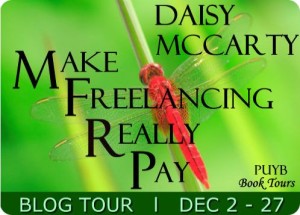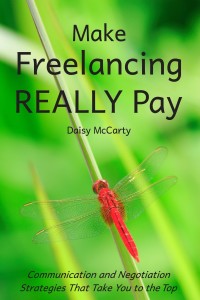Daisy McCarty is a self-educated writer and co-founder of Freelance Text, a professional services firm that specializes in web content creation. Since transitioning out of a seven year career in Corporate Procurement in 2008, Daisy has been using her negotiating skills to navigate to the higher levels of the online writing industry. Today, she mentors informally at Professional Freelancers Network, and offers formal one-on-one consulting services to freelancers who are ready to increase their income.
Her latest book is Make Freelancing REALLY Pay: Communication and Negotiation Strategies That Take You to the Top.
You can read Daisy’s blog and get more great freelancing advice at http://makefreelancingpay.com.
Connect & Socialize with Daisy!
TWITTER * FACEBOOK
“Make Freelancing REALLY Pay” helps new and struggling freelancers dramatically improve their business with expert communication and negotiation strategies. This book is a collection of real-life guidelines, tips, and tactics for overcoming common challenges. Readers learn how to select the best clients, expand their business, raise their rates, stabilize their income, and much more.
Purchase your copy at AMAZON
Discuss this book in our PUYB Virtual Book Club at Goodreads by clicking HERE
First Chapter:
Chapter 1: Choose the Most Profitable Clients
The earning potential of your freelance career is directly tied to the quality of your client base. Be selective.
If you are new to freelancing, it can be quite a shock to find out how little some clients expect to pay for professional services. The next big disappointment is discovering that so many freelancers are eager to agree to this arrangement and offer their services for such low prices.
There will always be people who participate in this cycle of exploitation. However, you shouldn’t let this fact discourage you. Because a substantial percentage of these low-paying projects are highly visible in the online marketplace, it’s easy to think that this is how most of the freelance world works. This isn’t the case. There’s an entirely different dynamic playing out behind the scenes.
If you’ve ever pursued a traditional career in the corporate world, you know that the best jobs aren’t necessarily advertised on the online job boards, such as CareerBuilder.com or Monster.com. Instead, many of these open positions are filled through networking, referrals, and headhunting. This is because there will never be a replacement for word-of-mouth advertising. In the same way, a high percentage of your most lucrative client relationships will be formed because your clients tell others about the quality of your services.
How Do You Get to That Point?
You need to find a way into the network. There are many ways to do this, depending on your area of expertise. I chose the freelance bidding platforms as my starting point. As a result, a few of the strategies I provide in this book are particularly helpful for freelancers looking to find work through online project postings.
I know there are freelancing experts who claim it is not possible to source well-paying clients on bidding sites. Or, they say it is a waste of your time to even look because you have to sort through low-paying jobs to find good projects. I disagree. I have figured out how to use these sites efficiently to identify high-paying clients who serve as entry points into the world of referral-based work. I want to offer practical and factual advice about how to use these sites appropriately instead of categorically warning freelancers away.
However, I do not suggest that you try to earn your entire income on bidding sites. They are simply a source of potential clients who already know they want to hire a freelancer. You can and should find additional ways to get noticed for your skills if you want to build your business income quickly.
Here are a few of the ways that other successful freelancers do this:
– Networking face-to-face or virtually in circles where they can meet and pitch potential clients
– Engaging in professional networking online with other freelancers on sites such as LinkedIn that attract the attention of prospective clients
– Directly soliciting new clients via email, phone, or other types of communication
– Reaching out to contacts from their previous careers in traditional employment
– Marketing through their own freelancing websites and social media (this approach may require more skill and experience than the other methods, depending on the level of competition in your field)
I invite and encourage you to explore all of these avenues for finding work. As you experiment, you may discover more ways to get your portfolio in front of the right people. The basic principles of client selection still hold true no matter where you find your clients.
Why Is It Important to Be Choosy about Your Clients?
The quality of the clients you work with now may determine the quality of clients who are referred to you in the future. People with the same standards, ethics, and level of professionalism tend to run in the same circles (this is no different in business than it is in other areas of life). If you work for clients who take advantage of you, they are telling all of their friends, “Hey! I found this great freelancer with cheap prices. You should hire him too.” Every time you do a job for a client with that mindset, you aren’t just losing income by doing one low-paying project. The entire line of referrals that spring from that project may be tainted.
If you do a small and appropriately priced project for an excellent client, you are tapping into the potential for more work with clients of the same caliber. You can earn the same amount for a small project with a client who does value your work as you do for a larger project with a client who does not value your work. You then have extra time to develop your skills and look for additional projects with high quality clients.
I know there are times when it seems necessary to do a poorly paid project so you can put food on the table or pay the bills. I’m not judging—I’ve done the same thing. I am encouraging you not to make this an ongoing pattern.
The bottom line is this: if you are doing so much cheap work that you don’t have the time you need to seek out more profitable clients, success will never arrive.
One of the goals of this book is to help you figure things out faster so you aren’t desperate for work. This puts you in a much stronger negotiating position and makes it easier to charge what your services are worth.
My Top Three Client Categories
Over the years, I’ve noticed that certain types of clients tend to be well-paying and professional. My suggestions regarding which clients you should work with are not hard-and-fast rules. They are guidelines that allow you to focus your marketing and networking efforts on those clients who are most likely to help your freelance business grow.
Category #1: Small- to Mid-Sized Business Owners
I love doing business with successful small- to mid-sized business owners. These are clients who have established a record of excellence and simply need help moving to the next level. Smaller businesses also tend to have lots of connections with other clients who are looking for reliable, professional freelancers. Many of these clients don’t have in-house talent or an established network of service providers. Often they are first-time buyers who have never hired a freelancer. That’s a good thing. They haven’t learned bad habits and aren’t jaded by unpleasant or disappointing experiences.
Negotiation with these clients is usually not complex. You are dealing directly with a decision maker who has a vested interest in obtaining high quality services to improve the profitability of their company. If you are willing to spend time communicating with a small- or mid-sized business owner and show them the ropes, this can pay off.
You can start educating this type of client in your proposal. I may do this by asking questions that help them clarify their business objectives or by offering one or two pieces of advice that they will find helpful regardless of whether they hire me or someone else. The quality of my communication sticks in their mind. I have had prospective clients decline my proposal, then make contact months or years later to ask me to do a project for them. If you are planning to freelance for a long time, be patient. Each time you make a stellar first impression, the seeds you plant may bear fruit later.
Category #2: Business-to-Business Firms
In my experience, the highest-paying clients with the longest contracts tend to be business-to-business (B2B) companies rather than business-to-customer (B2C) companies. B2Bs stand to make a lot of money every time your services help win them a new customer. Instead of each new customer being worth $50 or maybe $500, a new business relationship might mean $5,000 or $50,000 or more over the long term. Obviously, these B2B clients are happy to pay premium rates for valuable services. They understand the business benefits clearly, so you just need to demonstrate that you know how to deliver the results they want.
Who are these clients? They may be small- to mid-sized businesses or enterprises in any number of markets. However, many of the B2B clients I’ve come across are consulting or professional services firms, including many sole proprietorships and partnerships. These clients are ideal for freelancers to target because they have a healthy budget without too many people involved in the decision making. Consulting firms in particular know what professional freelancers should be paid and don’t suffer from sticker shock when they see your pricing. They are also fairly ‘hands-off’, respecting the fact that you know what you are doing. They understand the difference between an employee and a freelancer, and they treat you appropriately.
If you want to land these clients, you need to know what type of services they are looking for right now. We’ll talk more about how to do that in Chapter 3.
Category #3: Larger Firms That Need Extra Talent
Subcontracting your services to a larger company is a bit of a touchy subject in freelancing circles. There are plenty of outsourcing firms that like to hire freelancers for cheap labor. However, there are also many firms that have a core of internal talent and simply need to supplement it with experienced freelancers who bring in additional skills. For example, I have done freelance subcontract work writing for online media marketing, web design, web development, and SEO firms (you’ll notice the overlap here with the B2B category). These companies can provide consistent work and lots of opportunities for referrals.
The strategy for making things work with these clients is to resist the pressure to mark down your prices too far in exchange for the promise of bulk work. Don’t buy into the idea that they are hurting for cash. Trust me; they are marking your work way up when they pass it on to clients.
If you have a proven track record of landing your own clients without help, you can stick to your guns during negotiations. These companies should be hiring you because you help make them look good—not because you are cheap. If you are delivering exceptional services, you are helping them grow their business. This increase in overall profitability is worth the price you charge.
What about Big Businesses?
I do provide services to some enterprise-class organizations. These are great projects, and they pay very well. You can certainly try to land a ‘big fish’ at any time—especially if you have some fantastic portfolio samples in relevant industries. However, getting in touch with the decision makers can be tough. They are usually located deeper within the referral network where you might not have easy access.
If you do get a chance to work with a big client, negotiate the right to display a sample from the project in your portfolio. If this is not permitted because the project includes a nondisclosure agreement, ask for a short testimonial instead. You can display these testimonials on your website or reference them in future proposals. Having a few Fortune 500 clients who support your marketing efforts definitely increases the perceived value of your services.
Note: Don’t view landing a couple of big clients as a way to end your search for new clients. Relying on a handful of clients for all your income places you in a poor negotiating position and puts your business at risk.
Pump Up Your Book and Daisy McCarty are teaming up to give you a chance to win one of (5) $25 Amazon Gift Cards & one of (5) 1 hour sessions of consulting services!
Terms & Conditions:
- By entering the giveaway, you are confirming you are at least 18 years old
- Ten winners will be chosen via Rafflecopter to receive one of five $25 Amazon Gift Cards or one of five one hour sessions of consulting services
- This giveaway begins December 2 and ends December 27.
- Winners will be announced on this page and contacted via email on Monday, December 30, 2013.
- Winner has 48 hours to reply.
Good luck everyone!
ENTER TO WIN!
Make Freelancing Pay Blog Tour Page:





